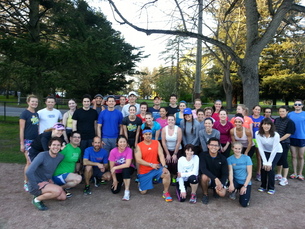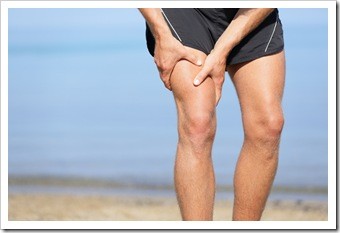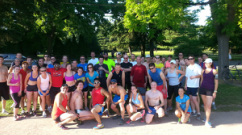Are you a runner and have pain on the outside of your knee? |
|||||||||||||
| sglrg_track_warm_up.pdf | |
| File Size: | 92 kb |
| File Type: | |

This will be a 2 part series designed to explain the “why” behind the different exercises I guide the Green Lake track workout group through every Monday evening.
We always start with 2 laps of slow jogging to get the blood flowing. At lap 3, on the straight sections, we begin the running drills. Those technique modifications include running with feet normal width apart with toes turned in and then toes turned out. The next set of alterations move feet further apart than normal with toes neutral, turned in and turned out. And the final set involves the feet coming across midline with toes neutral, turned in and turned out. To explain the effects in detail, I will limit the discussion to one variable at a time.
Modifications Introduced While Running
Toes Turned In
Toes Turned Out
Feet Wide
Feet Across Midline
All joints and muscles load and unload 3-dimensionally during any activity – this allows your muscles to decelerate and or accelerate motion in one to three planes of motion. Adjusting motion and exercise patterns is critical for maintaining mobility with strength and keeping your body healthy.
There will be little difference if you are a heel, midfoot or forefoot striker with these drills. The overarching purpose of these movements is to increase motion while at the same time teaching your body to control new motion. Waking up as many muscle groups and nerve pathways (or to be more precise, proprioceptors) as possible before running or any activity is always crucial and this is often best accomplished by introducing variable movements.
Next Segment: Part 2 – Lunges with 3D Arm Reaches
Dan Benson, DPT, OCS, FAFS, GPS, CAFS, FMR
CEO Forefront Physical Therapy
Doctor of Physical Therapy
Orthopedic Certified Specialist
Fellow of Applied Functional Science from the Gray Institute
Nike Golf Performance Specialist
Certified in Applied Functional Science
Certified in Functional Manual Reaction
www.forefrontpllc.com
We always start with 2 laps of slow jogging to get the blood flowing. At lap 3, on the straight sections, we begin the running drills. Those technique modifications include running with feet normal width apart with toes turned in and then toes turned out. The next set of alterations move feet further apart than normal with toes neutral, turned in and turned out. And the final set involves the feet coming across midline with toes neutral, turned in and turned out. To explain the effects in detail, I will limit the discussion to one variable at a time.
Modifications Introduced While Running
Toes Turned In
- What the Runner Feels: increased activation of butt muscles during the initial loading phase (foot strike) and increased stretch to hip flexors during late stance phase.
- What the Movement Expert Says: there is decreased pronation due to increased hip internal rotation during the loading phase and increased supination and hip internal rotation during the late stance phase. There is also increased thoracic spine rotation which means increased core loading.
Toes Turned Out
- What the Runner Feels: decreased activation of butt muscles during the loading phase and decreased activation of hip flexors during late stance phase.
- What the Movement Expert Says: there is increased pronation and decreased ability for the gluteus muscles to activate during loading phase (because pronation has improved, the hip will internally rotate, just not as far as usual) and decreased supination during the late stance phase. There is decreased thoracic spine rotation which means less core (front and back) ability to stretch and activate to help with all phases of the running cycle – this teaches the body to use and control motion without its typical resources.
Feet Wide
- What the Runner Feels: decreased butt muscle activation during loading phase and variable hip flexor loading during late stance phase.
- What the Movement Expert Says: there is increased pronation during loading phase and decreased supination during late stance phase. Despite the increased pronation, with your feet wide, it is harder to recruit the gluteus muscles due to a lack of hip adduction during loading phase; the hip flexor likely loses much of the internal rotation pre-load during late stance phase but receives a better frontal plane load relative to running. There is decreased core loading due to decreased thoracic spine rotation.
Feet Across Midline
- What the Runner Feels: increased butt muscle activation during loading phase and less ideal hip flexor loading during late stance phase.
- What the Movement Expert Says: there is decreased pronation during loading phase, and increased supination during late stance phase. This produces improved gluteus muscle loading due to improved hip adduction during loading phase; there is decreased frontal plane load to hip flexors during late stance phase but increased hip internal rotation. At the mid back there is improved core loading due to increased pelvis tilt and rotation creating increased thoracic spine Type I mechanics (opposite side rotation and side bending).
All joints and muscles load and unload 3-dimensionally during any activity – this allows your muscles to decelerate and or accelerate motion in one to three planes of motion. Adjusting motion and exercise patterns is critical for maintaining mobility with strength and keeping your body healthy.
There will be little difference if you are a heel, midfoot or forefoot striker with these drills. The overarching purpose of these movements is to increase motion while at the same time teaching your body to control new motion. Waking up as many muscle groups and nerve pathways (or to be more precise, proprioceptors) as possible before running or any activity is always crucial and this is often best accomplished by introducing variable movements.
Next Segment: Part 2 – Lunges with 3D Arm Reaches
Dan Benson, DPT, OCS, FAFS, GPS, CAFS, FMR
CEO Forefront Physical Therapy
Doctor of Physical Therapy
Orthopedic Certified Specialist
Fellow of Applied Functional Science from the Gray Institute
Nike Golf Performance Specialist
Certified in Applied Functional Science
Certified in Functional Manual Reaction
www.forefrontpllc.com
| sglrg_track_warm_up.pdf | |
| File Size: | 92 kb |
| File Type: | |
Details
Forefront Authors
We love writing about injury prevention and functional exercise. We want everyone to share in our motto: movement for a healthy life!
Archives
June 2020
December 2019
July 2019
January 2018
December 2017
November 2017
October 2017
August 2017
October 2016
October 2015
September 2015
November 2014
June 2014
May 2014
November 2013
January 2013
August 2012
Categories
All
Ankle Sprains
Exercise
Function
Golf
IT Band
Knee
Running
Shoes
Sitting
Soccer
Winter Skiing



 RSS Feed
RSS Feed
